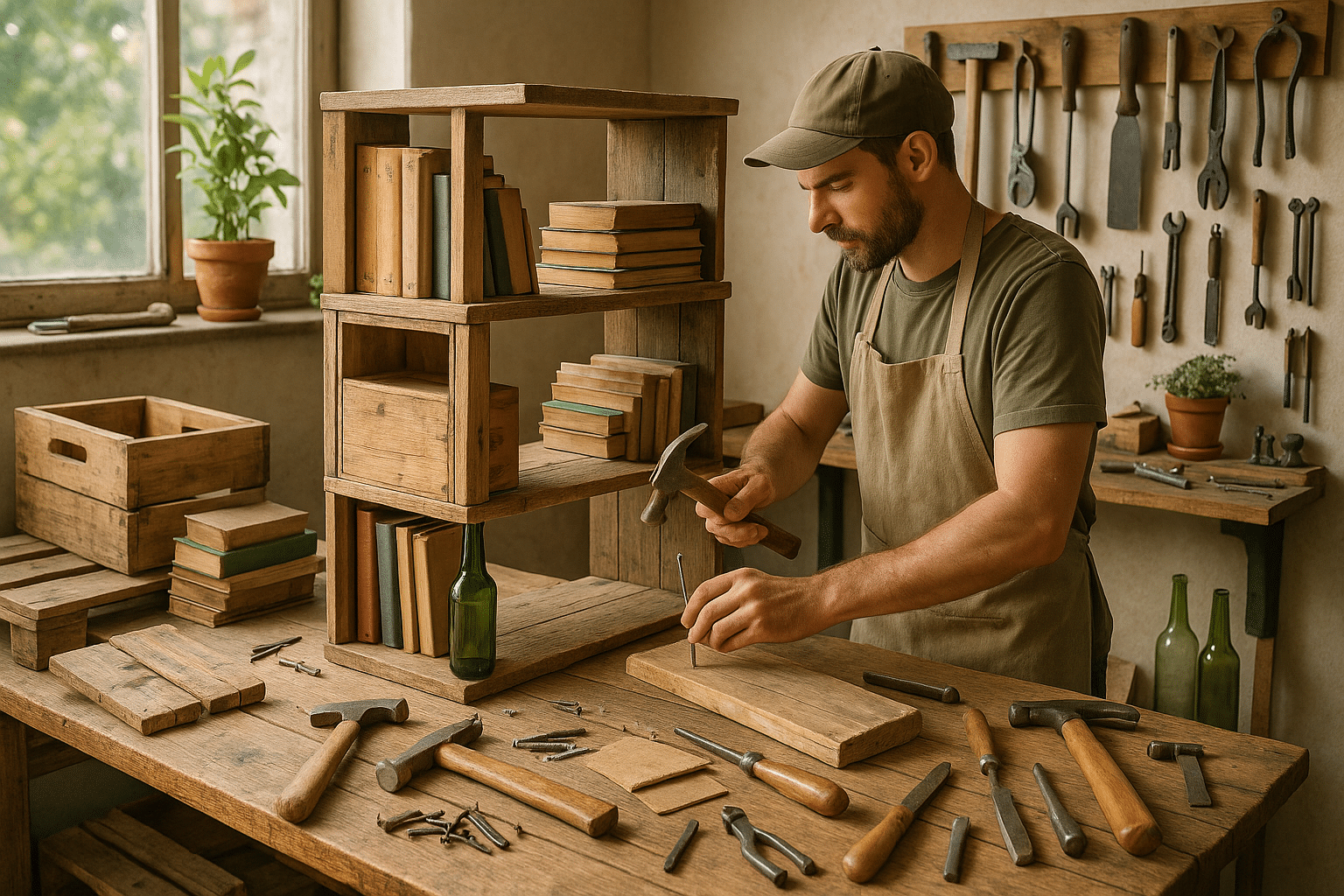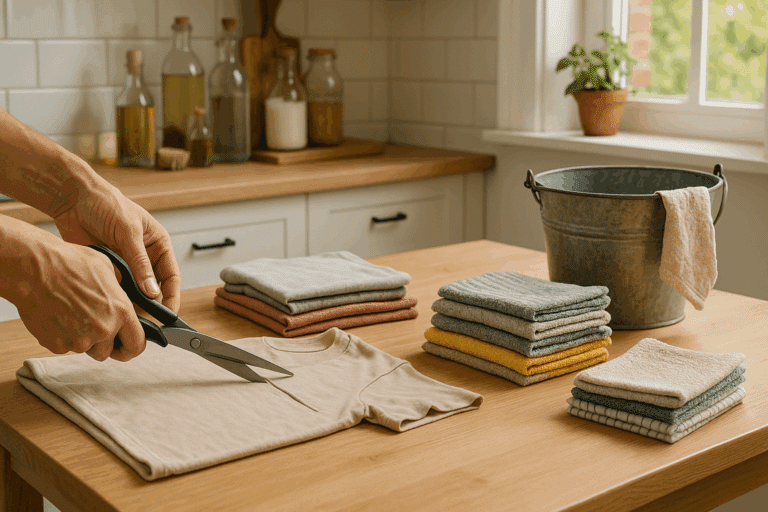If so, then you’ve landed in the right place! 🎯
Our world is creaking under the weight of waste and one of the best ways to contribute to the solution is by recycling. But recycling doesn’t just mean separating your plastic bottles and paper; it can also mean transforming what might otherwise be discarded into something stylish and practical. In this article, we’ll show you how to do just that by building an eco-friendly bookshelf using recycled materials and without the use of power tools. ✨
Why DIY projects, you may wonder? Well, DIY projects are a fantastic way to cultivate new skills, express creativity, and yield tangible, satisfying results. In this instance, not only will you be creating a unique piece for your home, but you’ll also be reducing your carbon footprint – a win-win situation! 🌎
Before we dive into the specifics, let’s clear up any lingering doubts about the feasibility of such a project. Building a bookshelf without power tools may seem like a tall order. But the truth is, human ingenuity knows no bounds. With a bit of guidance, even the most daunting of tasks can be broken down into manageable steps. And this is precisely what we’ll be doing throughout this guide.
🔨 The Joy of Hand Tools 🔨
In our tech-driven world, it’s easy to forget the joy and satisfaction derived from using hand tools. Sure, power tools can get the job done quickly, but they often remove us from the sensory experience of creating something with our own hands. Hand tools offer a connection to the materials and the process that power tools simply can’t. Plus, they are quieter, safer, and more environmentally friendly!
♻️ The Appeal of Recycled Materials ♻️
Recycled materials, on the other hand, come with their own set of appeals. They are readily available and usually free, adding a touch of thriftiness to your project. Moreover, each piece carries its own story and unique characteristics, lending a certain charm and individuality to your creation that new, off-the-shelf materials just can’t match.
In this guide, we will provide step-by-step instructions to help you build a stylish bookshelf using only hand tools and recycled materials. We’ll discuss the types of materials you can recycle, the hand tools required, how to design your bookshelf, and finally, the step-by-step construction process. So, whether you’re a seasoned DIY enthusiast or a beginner looking to dip your toes into the realm of hand tools and recycled materials, this guide has got you covered! 😎
Building a bookshelf without power tools using recycled materials is not just an exercise in creativity, but also a statement. A statement about the responsible use of resources, the joy of making, and the possibilities that lie in the items we so readily discard. It’s about rolling up your sleeves, getting a bit dusty, and relishing in the delight of creating something with your own hands. Ready to join the journey? 🚀 Let’s get started!
Introduction to Eco-Friendly DIY Bookshelf Building
Engaging in eco-friendly DIY projects is not only fun but also a step towards preserving our planet. One such DIY project is building a stylish bookshelf without power tools. This article will guide you on how to build a bookshelf using recycled materials that will not only add a touch of style to your home but also contribute to environmental conservation. Buckle up and let’s get started.
It’s crucial to understand that building a bookshelf without power tools doesn’t mean compromising on the final product’s quality. In fact, you might be surprised at how sturdy and stylish a bookshelf made from recycled materials can be. Plus, the process itself is quite enjoyable. Let’s dive into the details!
The Power of Recycled Materials
In recent years, the use of recycled materials in DIY projects has gained significant popularity. Not only do these materials reduce waste, but they also offer unique aesthetics that can’t be achieved with new materials. From wooden pallets to old ladders, there’s a vast array of materials you can use to create your eco-friendly bookshelf.
Choosing Your Materials
The first step in your DIY project is to choose the right materials. Using recycled materials doesn’t mean you have to compromise on the style or quality of your bookshelf. You might be surprised at the variety of materials you can use.
For example, you could use old wooden crates or pallets, which can be found in many places for free or at a very low cost. Alternatively, you could use an old ladder or reclaimed wood. The options are endless, and the choice is yours.
Take a look at the table below to compare the different materials you could use for your eco-friendly bookshelf.
| Material | Pros | Cons |
|---|---|---|
| Wooden Crates | Easily available, sturdy, unique aesthetic | May require some cleaning or sanding |
| Pallets | Available for free in many places, rustic look | Can be difficult to disassemble |
| Old Ladder | Can be used as-is for a unique bookshelf | May need to be reinforced for stability |
Now that you’ve chosen your materials, it’s time to start building!
Building Your Eco-Friendly Bookshelf
The process of building your bookshelf will vary depending on the materials you’ve chosen. However, there are some general steps you can follow.
For example, if you’re using wooden crates, you might choose to stack them on top of each other or side by side, securing them with wood glue and nails. If you’re using an old ladder, you could simply lean it against a wall and use the rungs as shelves.
Regardless of the materials you use, be sure to take your time and make sure everything is secure. Remember, this is a project to enjoy, not rush.
Step-by-Step Guide to Building a Pallet Bookshelf
Here’s a detailed step-by-step guide on how to build a bookshelf from a pallet.
- First, disassemble the pallet, removing any nails.
- Next, decide on the size of your bookshelf and cut your boards accordingly.
- Then, arrange your boards into a box shape, with two boards on the top and bottom and two on the sides.
- Finally, secure the boards together with wood glue and nails.
Remember, this is just one way to build a bookshelf from a pallet. Feel free to get creative and experiment with different designs.
For more detailed instructions, watch the following YouTube video: “DIY Pallet Bookshelf” from the “Home Repair Tutor” channel.
Maintaining Your Eco-Friendly Bookshelf
Just like any other piece of furniture, your eco-friendly bookshelf will need some maintenance to keep it looking great and functioning properly.
Cleaning your bookshelf regularly is key. Dust and dirt can accumulate, especially if the bookshelf is made of untreated wood. A simple dusting or vacuuming can often do the trick. If you need to do a deeper cleaning, be sure to use products that are safe for the material your bookshelf is made from.
You might also need to do some minor repairs from time to time, such as tightening loose screws or re-gluing parts that have come loose. Remember, regular maintenance can extend the life of your bookshelf and keep it looking its best.
Protecting Your Bookshelf
Additionally, you might want to consider applying a protective finish to your bookshelf, especially if it’s made of wood. This can help to protect the wood from damage and enhance its appearance. Options include varnish, wax, or oil.
Take a look at the following YouTube video for more information on how to apply a protective finish to your bookshelf: “How to Apply a Protective Finish to Your Bookshelf” by “Woodworkers Journal“.
Wrap Up
Building a stylish bookshelf without power tools using recycled materials is an eco-friendly DIY project that anyone can undertake. Not only will you end up with a unique piece of furniture, but you’ll also be contributing to the preservation of our planet. Remember to choose your materials carefully, take your time with the building process, and maintain your bookshelf properly to ensure it lasts for many years.
This project can be a lot of fun and very rewarding. So why not give it a try? You might be surprised at what you can create with a little imagination and some recycled materials.
Happy building! 🛠️📚🌳

Conclusion
As we conclude our in-depth exploration of Data Structures and Algorithms in software engineering, it’s essential to recapitulate the main points that we’ve addressed throughout this article. For your convenience, I’ve integrated a few clickable HTML tags to facilitate your return to any section for review.
We began our journey with an introduction to Data Structures 📚, exploring the critical role they play in software engineering. Through real-world examples, we explained how data structures allow us to organize, manage, and store data efficiently. The better the data structure, the better the efficiency of our code.
We then plunged into the world of Algorithms ⚙️, where we unraveled the significance of these step-by-step procedures in solving problems or achieving a particular output. The efficient execution of algorithms not only enhances the performance of your code but also saves time and resources.
Throughout the article, we have examined various types of Data Structures (arrays, linked lists, trees, graphs, etc.), and types of Algorithms (searching, sorting, recursive, backtracking, etc.), providing a detailed analysis of each with their specific applications and benefits.
As we navigated further, we emphasized the importance of Data Structures and Algorithms in software engineering. 💻 A solid understanding of these concepts equips software engineers with the ability to write more efficient and effective code. It helps in understanding the big O notation, enhancing problem-solving skills, and making effective decisions during the system design process.
In the application section, we brought these technical concepts to life, discussing how they are implemented in real-world scenarios like social networking, Artificial Intelligence, operating systems, and more.
Ultimately, our exploration underlines the fact that Data Structures and Algorithms are foundational to software engineering. They are not merely academic concepts but practical tools that, when used effectively, can lead to the creation of robust and efficient software systems.
I hope that this article has not only increased your knowledge but also kindled a spark of curiosity to delve deeper into the intriguing world of Data Structures and Algorithms. If you have found this article informative and engaging, don’t hesitate to leave a comment below, share it with your peers 🌐, or apply what you’ve learned in your own projects.
Keep in mind that learning is a continuous process; never stop exploring and expanding your horizons. As Albert Einstein once said, “The more I learn, the more I realize how much I don’t know.”
As a final note, always remember to validate your knowledge through application. After all, the ultimate proof of understanding a concept lies in its successful application. 🚀
Keep learning, keep coding!
Sources:
[1] [2] [3] [4] [5]



